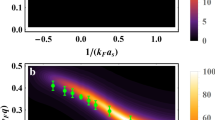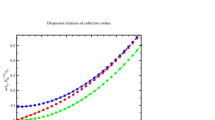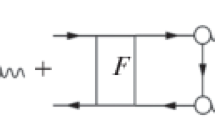Abstract
Interpretations of the characteristic phonon-roton excitations in superfluid4He are discussed to assess the role of the condensate. In the celebrated Landau, Feynman, Feenberg and subsequent Correlated Basic Function methods, the phonon-roton excitations are interpreted as collective density excitations. This picture, suitably modified at higher Q to take account of the correlated motion of neighbors (backflow), provides our best description of neutron scattering data at low temperature. The condensate does not play an explicit role. In the Field Theory, second quantized formulation of Bogoliubov, Hugenholtz and Pines, Gavoret and Nozières and the subsequent Dielectric Function formulation, the condensate plays an explicit role. Because of the condensate, both regular density (particle-hole) and single particle excitations contribute to the density response. The regular density (two-particle) and single particle excitations mix as particles scatter into and out of the condensate. This Density-Quasiparticle picture provides a good description of the temperature dependence of neutron scattering data. From this description, the phonon at low Q is interpreted as a joint density/quasiparticle mode strongly coupled via the condensate. At higher Q, the sharp maxon-roton is interpreted as a quasiparticle excitation less strongly coupled into the density. The sharp maxon-roton peak is a unique feature of the condensate and could not be observed in S(Q, ω) without a condensate.
Similar content being viewed by others
References
E.F. Talbot, H.R. Glyde, W.G. Stirling and E.C. Svensson, Phys. Rev.B38, 11229 (1988)
H.R. Glyde and W.G. Stirling, inPhonons 89 edited by S. Hunklinger, W. Ludwig and G. Weiss (World Scientific, Singapore, 1990)
W.G. Stirling and H.R. Glyde, Phys. Rev.B41, 4224 (1990)
H.R. Glyde and A. Griffin, Phys. Rev. Lett.65, 1454 (1990)
see A. Griffin, E.C. Svensson, W.G. Stirling, H.R. Glyde inExcitations in 2D and 3D Quantum Fluids, edited by A.F.G. Wyatt and H.J. Lauter (Plenum, NY 1990)
W.S. Wu, S.A. Vitiello, L. Reatto and M.H. Kalos, Phys. Rev. Lett.67, 1446 (1991)
G.W. Masserini, L. Reatto, and S.A. Vitiello, Phys. Rev. Lett.69, 2098 (1992)
Yu. A. Nepomnyashchy, Phys. Rev.B46, 6611 (1992)
S. Stringari, Phys. Rev.B46, 2974 (1992)
H.R. Glyde, Phys. Rev.B45, 7321 (1992)
B.E. Clements, E. Krotscheck and J.A. Smith (preprint) (1993)
K.H. Andersen, Ph.D. Thesis (Keele U.) 1991 and unpublished
K.H. Andersen and B. Fåk, Phys. Lett.A160, 468 (1991) and private comm.
K.H. Andersen, W.G. Stirling, R. Scherm, A. Stunault, B. Fåk, H. Godfrin, A.J. Dianoux, J. Phys. Cond. Matter (submitted)
B. Fåk, L.P. Regnault and J. Bossy, J. Low Temp. Phys.89, 345 (1992)
N.M. Blagoveshchenskii et al., Pis'ma (JETP) Lett.57, 414 (1993)
A.D.B. Woods and E.C. Svensson, Phys. Rev. Lett.41, 974 (1978)
For references to earlier work, see H.R. Glyde and E.C. Svensson, inNeutron Scattering, edited by D.L. Price and K. Sköld, Methods of Exp. Phys., Vol. 23, Part B, (Academic Press, NY 1987), p. 303
L.D. Landau, J. Phys. U.S.S.R.5, 71 (1941); 11, 91 (1947)
R.P. Feynman, Phys. Rev.94, 262 (1954)
R.P. Feynman and M. Cohen, Phys. Rev.102, 1189 (1956)
E. Feenberg,Theory of Quantum Fluids (Academic Press, NY, 1969)
H.W. Jackson and E. Feenberg, Rev. Mod. Phys.34, 686 (1962)
H.W. Jackson, Phys. Rev.A4, 2386 (1971) andA8, 1529 (1973)
C.E. Campbell, inProgress in Liquid Physics (C.A. Croxton, ed.) p. 213. (Wiley, New York, 1978)
E. Manousakis and V.R. Pandharipande, Phys. Rev.B30, 5062 (1984)
E. Manousakis and V.R. Pandharipande, Phys. Rev.B33, 150 (1986)
C.E. Campbell, in Condensed Matter Theories, Vol. 8, edited by L. Blum and F.B. Malik (Plenum, NY, 1993)
N.N. Bogoliubov, J. Phys. U.S.S.R.11, 23 (1947)
S.T. Beliaev, Sov. Phys. JETP7, 289 (1958)
N. Hugenholtz and D. Pines, Phys. Rev.116, 489 (1959)
J. Gavoret and P. Nozières, Ann. Phys. NY28, 349 (1964)
A.A. Nepomnyashchy and Yu. A. Nepomnyashchy, Sov. Phys. JETP Lett.21, 1 (1975); Yu. A. Nepomnyashchy and A.A. Nepomnyashchy, Sov. Phys. JETP48, 493 (1978)
P.C. Hohenberg and P.C. Martin, Phys. Rev. Lett.12, 69 (1964)
S.-k. Ma and C.W. Woo, Phys. Rev.159, 165 (1967)
A. Griffin and T.H. Cheung, Phys. Rev.A7, 2086 (1973)
P. Szépfalusy and I. Kondor, Ann. Phys., NY82, 1 (1974)
P. Nozières and D. Pines,The Theory of Quantum Liquids, Vol. II (Addison-Wesley, NY, 1990)
D. Pines in Physics Today,42 (2), 61 (1989)
R.J. Donnelly, J.A. Donnelly, and R. N. Hills, J. Low Temp. Phys.44, 471 (1981)
A. Bijl, Physica7, 869 (1940)
D.K. Lee and F.J. Lee, Phys. Rev.B11, 4318 (1975)
V.F. Sears, E.C. Svensson, P. Martel, and A.D.B. Woods, Phys. Rev. Lett.49, 279 (1982)
E.C. Svensson and V.F. Sears, inFrontiers of Neutron Scattering (R.J. Birgeneau, D.E. Moncton, and A. Zeilinger, eds.) p. 126. North-Holland, Amsterdam, 1986. [Reprinted from Physica137B, 126 (1986).]
P.E. Sokol and W.M. Snow in Ref. 5
T.R. Sosnick, W.M. Snow, R.N. Silver and P.E. Sokol, Phys. Rev.B43, 216 (1991)
W.G. Stirling, inProceedings of the 2nd International Conference on Phonon Physics, edited by J. Kollar, N. Kroó, N. Menyhard, and T. Siklos (World Scientific, Singapore, 1985), p. 829.
D. Pines inQuantum Fluids, edited by D.F. Brewer (North Holland, Amsterdam, 1966), p. 257.
For a detailed derivation of (12), see H.R. Glyde, inCondensed Matter Theories, edited by L. Blum and F.B. Malik, (Plenum, New York, 1993) p. 159.




